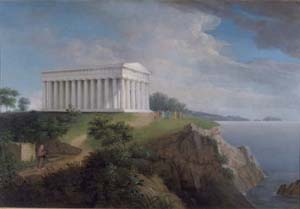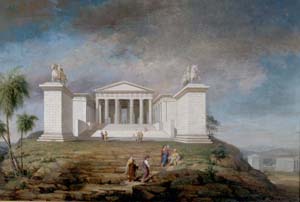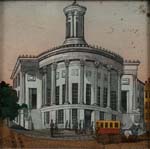Art & Artifacts
Discover the Library Company's Art and Artifact Collection
Athens of America
Philadelphia has long been hailed the “Athens of America” for its rich intellectual life. References can be found as early as 1733 when the Library Company’s directors wrote, “May your Philadelphia be the future of Athens in America.”1 It is not far-fetched to imagine the comparison; Philadelphia, after all, was founded as a safe haven for religious tolerance and soon became a vital meeting ground for the Founding Fathers. Indeed, the name itself, “Philadelphia,” comes from the Greek “brotherly love,” its now synonymous nickname. In the 19th century, Philadelphia’s architecture would reflect a Greek Revival. Contemplating the relationship between art and political power, renown architect and engineer Benjamin Latrobe remarked in 1811 that the “days of Greece may be revived in the woods of America, and Philadelphia become the Athens of the Western World.”2 Within the Library Company collection, it is clear the sway that the Greeks had on early American artists and thinkers, particularly in these representations of Philadelphia’s supposedly ancient counterpart.
William Strickland (1788-1854).
Landscape with Temple on a Cliff.
Oil on Canvas.
Library Company of Philadelphia. Bequest of Dr. James Rush, 1869.
William Strickland (1788-1854).
Academic Study (Possibly of the Acropolis in Athens).
Oil on Canvas.
Library Company of Philadelphia. Bequest of Dr. James Rush, 1869.
William Strickland, Landscape with Temple on Cliff; An Academic Study (Possibly of the Acropolis in Athens)
William Strickland is celebrated for his achievements in neoclassical architecture and is associated with Greek Revival in America. He apprenticed under Benjamin Latrobe, who helped launch his career as an architect. His design of the Second Bank, modeled on the Parthenon in Athens, was historic for its impact on neoclassicism and Greek Revival. Before Strickland established himself as an architect, however, he spent his early years drawing, engraving, and painting. These two academic studies illustrate his Greek influences. It is clear that Strickland used the visual vocabulary of neoclassical architecture to communicate a sense of grandeur, calm, and strength.
Merchant's Exchange, Philadelphia.
Reverse painting on glass.
Library Company of Philadelphia. Gift of David Doret, 2002.
Merchant’s Exchange, Philadelphia
The Merchant’s Exchange was constructed between 1832 and 1834 at the corner of Walnut, Dock, and Third Streets. The building is an exquisite expression of the Greek Revival style and operated as a brokerage house. Strickland drew inspiration from the Choragic Monument of Lysicrates and the Tower of the Winds in Athens. The building contains a wealth of Greek elements, such as the Corinthian columns, porticos, and pediment. But Strickland’s design contained adaptations, including towers, which have no precedent in Greek architecture.
[1] Directors of the Library Company to Thomas Penn, 31 May 1733, in the Papers of Benjamin Franklin, ed. Leonard W. Labaree, et al. (New Haven: Yale University Press, 1959), 1: 320-1.
[2] Benjamin Henry Latrobe, Anniversary Oration Pronounced before the Society of Artists of the United States (Philadelphia: Bradford and Inskeep, 1811), 17.


